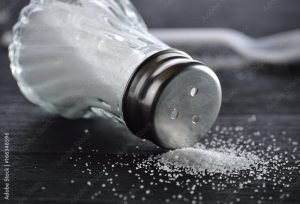 Salt, an essential mineral, plays a pivotal role in our diets. Not only does it enhance the flavor of our food, but it also performs crucial functions in our body, such as maintaining fluid balance and transmitting nerve impulses. However, like many things, moderation is key. This article aims to guide readers through the importance of salt, the potential harms of excessive intake, and practical ways to manage consumption without compromising on taste.
Salt, an essential mineral, plays a pivotal role in our diets. Not only does it enhance the flavor of our food, but it also performs crucial functions in our body, such as maintaining fluid balance and transmitting nerve impulses. However, like many things, moderation is key. This article aims to guide readers through the importance of salt, the potential harms of excessive intake, and practical ways to manage consumption without compromising on taste.
Understanding Salt and Its Dietary Importance
Salt, chemically known as sodium chloride, is a compound that our bodies need to perform essential functions. Sodium, a component of salt, helps regulate blood pressure and volume, assists in muscle and nerve function, and is involved in fluid balance within the body. Despite its importance, our bodies require it in relatively small quantities.
The American Heart Association recommends that adults consume no more than 2,300 milligrams of sodium per day, which equates to about one teaspoon of salt. Ideally, aiming for no more than 1,500 milligrams can significantly benefit blood pressure and heart health, especially in individuals sensitive to sodium.
The Risks of Excessive Salt Consumption
Consuming too much salt can lead to several health issues, many of which stem from the increased blood pressure that high sodium levels can cause.
High Blood Pressure and Heart Disease: Excessive salt intake can cause the body to retain water, leading to an increase in blood pressure. High blood pressure is a significant risk factor for heart disease and heart attacks, as it puts additional strain on the heart and arteries.
Kidney Health: The kidneys use osmosis to extract excess sodium from the body, which is then excreted in urine. High salt intake can overload the kidneys, impairing their function. Over time, this can lead to kidney disease and increase the risk of kidney stones.
Risk of Stroke: High blood pressure, a consequence of too much salt, can also increase the risk of stroke by damaging and weakening the brain’s blood vessels, leading to bleeding or blockages.
Impact on Bone Health: Consuming too much salt can cause calcium loss, which is needed for bone strength. Over time, this can lead to conditions like osteoporosis, where bones become weak and fragile.
Identifying Hidden Salt in Foods
One of the challenges in managing salt intake is recognizing the hidden salt in processed and packaged foods. Here are tips for spotting and reducing hidden salt:
Common High-Salt Foods: Processed meats, canned soups, pizza, bread, and ready meals often contain high levels of salt. Condiments, like soy sauce and ketchup, can also be significant sources.
Reading Labels for Salt Content: Nutrition labels list the sodium content. Look for items labeled “low sodium,” “reduced salt,” or “no added salt” to make healthier choices.
Understanding Serving Sizes: Pay attention to the serving sizes indicated on labels. The sodium content listed may be much lower than the amount consumed if larger portions are eaten.
Next, we will explore Practical Strategies for Reducing Salt Intake, offering advice on how to cut back on salt gradually and substitute it with healthier alternatives. Following that, we’ll present a detailed guide on Cooking with Less Salt: A Three-Course Meal Example, demonstrating how to apply these strategies in a practical, flavorful meal.
Practical Strategies for Reducing Salt Intake
Reducing salt intake doesn’t have to compromise the taste of your meals. Here are effective strategies to help lower your salt consumption while still enjoying delicious and nutritious food:
Gradually Decrease Salt: Start by slightly reducing the salt in your recipes and over time, your taste buds will adjust. You’ll begin to enjoy the natural flavors of the food with less reliance on salt.
Use Herbs and Spices: Experiment with a variety of herbs and spices to flavor your food. Fresh or dried herbs, garlic, onion, citrus zest, and vinegar can add depth and complexity to dishes without the need for additional salt.
Choose Fresh or Frozen Over Canned: Whenever possible, opt for fresh or frozen fruits and vegetables over canned versions, which often contain added salt for preservation. If using canned products, look for “no salt added” labels or rinse the contents to wash away some of the sodium.
Cooking with Less Salt: A Three-Course Meal Example
Creating a flavorful three-course meal with minimal salt is easier than you might think. This example focuses on a balanced approach, adding salt only to one dish to enhance its flavor, while relying on other seasoning methods for the rest.
Starter: Vegetable Soup
Begin with a homemade vegetable soup. Use fresh vegetables, and for broth, choose a low-sodium option or make your own. Enhance flavor with herbs like basil, thyme, and oregano, plus a dash of black pepper.
Main Course: Herb-Roasted Chicken
For the main dish, prepare a herb-roasted chicken. Season the chicken with a rub made from olive oil, garlic, rosemary, thyme, and just a small pinch of salt to bring out the flavors without overdoing it. The herbs and garlic will infuse the chicken with rich flavors that require less salt.
Side Dishes: Rice and Steamed Vegetables
Cook rice and steam a selection of vegetables, such as carrots, broccoli, and green beans, without adding any salt. To enhance their natural tastes, squeeze a little lemon juice over the vegetables and fluff the rice with a fork after it’s cooked to add texture.
Combining Flavors for Maximum Impact
The key to this meal is the combination of flavors. The herb-roasted chicken, with its slight saltiness, complements the natural sweetness of the vegetables and the neutral taste of the rice. When eaten together, the chicken lends flavor to the other components, demonstrating that a little salt goes a long way.
Conclusion
Monitoring and managing your salt intake is crucial for maintaining good health, but it doesn’t mean you have to eat bland food. By understanding the risks associated with excessive salt consumption and employing strategies to reduce it, you can enjoy flavorful meals that are both nutritious and satisfying. Experiment with herbs and spices, be mindful of hidden salts, and remember that sometimes, a little pinch is all you need to bring a meal to life. Enjoy the journey to a healthier, less salty diet.









